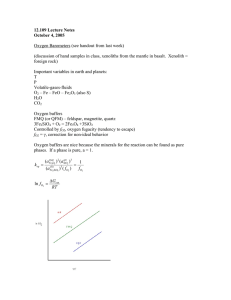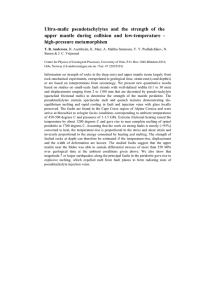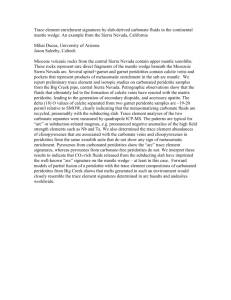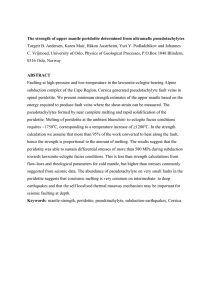12.109 Lecture Notes October 6, 2005 Petrology Pyroxene thermobarometry
advertisement
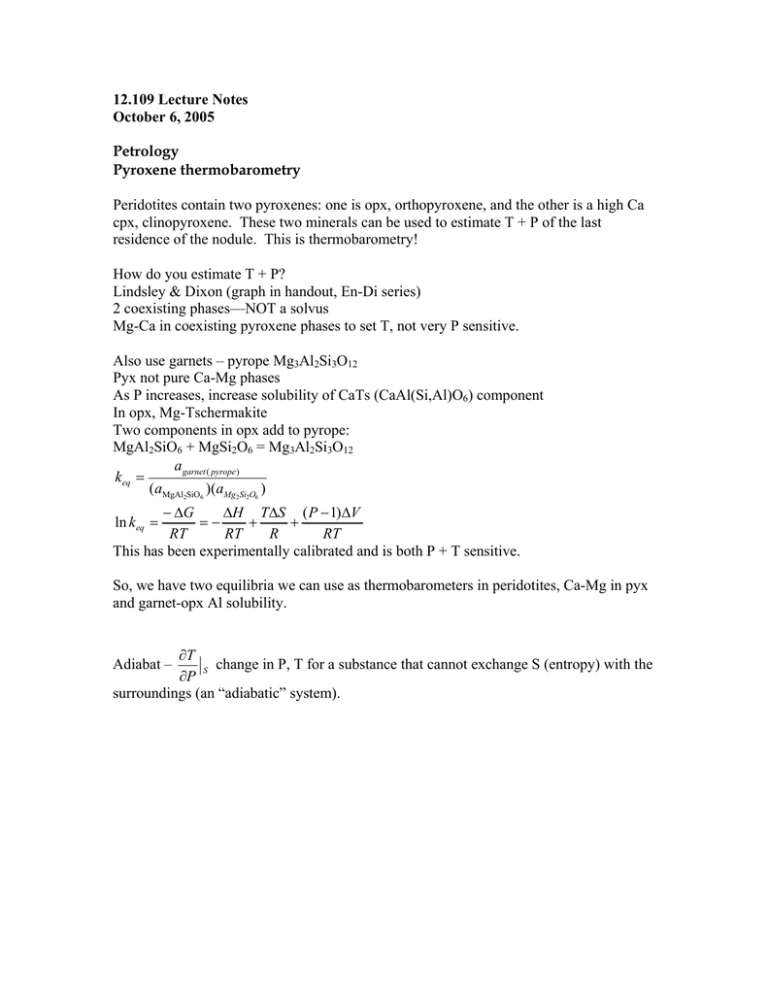
12.109 Lecture Notes October 6, 2005 Petrology Pyroxene thermobarometry Peridotites contain two pyroxenes: one is opx, orthopyroxene, and the other is a high Ca cpx, clinopyroxene. These two minerals can be used to estimate T + P of the last residence of the nodule. This is thermobarometry! How do you estimate T + P? Lindsley & Dixon (graph in handout, En-Di series) 2 coexisting phases—NOT a solvus Mg-Ca in coexisting pyroxene phases to set T, not very P sensitive. Also use garnets – pyrope Mg3Al2Si3O12 Pyx not pure Ca-Mg phases As P increases, increase solubility of CaTs (CaAl(Si,Al)O6) component In opx, Mg-Tschermakite Two components in opx add to pyrope: MgAl2SiO6 + MgSi2O6 = Mg3Al2Si3O12 a garnet ( pyrope ) keq = (aMgAl2SiO6 )(aMg2Si2O6 ) − ΔG ΔH TΔS ( P − 1)ΔV =− + + RT RT R RT This has been experimentally calibrated and is both P + T sensitive. ln keq = So, we have two equilibria we can use as thermobarometers in peridotites, Ca-Mg in pyx and garnet-opx Al solubility. ∂T S change in P, T for a substance that cannot exchange S (entropy) with the ∂P surroundings (an “adiabatic” system). Adiabat – Kimberlites erupt at 20-200 km/hr velocity According to Tom Jordan, 1970s Scientific American article, the Kaapvaal craton is >3 billion years old. How do you keep cratons stable? Buoyancy The less dense cratonic material floats on the mantle. Two types of buoyancy: 1. compositional (Mg lighter than Fe), 2. thermal (hot lighter than cold) How do you make cratons and keep things cold? Tim says you use a subduction zone. Water subducted with oceanic crust, lowers melting point of the rocks. Wet melting in the mantle wedge can be cooler than would be expected with dry melting. [picture of mantle wedge and volcanoes] In handout, studies of transition between garnet and spinel peridotite, also studies of pyroxenes. Pyroxene quadrilateral with isotherms See information on QUILF, DH Lindsey What happens to peridotite when you metamorphose it in the presence of H2O? SERPENTINIZATION Pieces of mantle emplaced tectonically into continental crust are alpine peridotites. Steinmann (Swiss) found association between serpentine peridotite, pillow basalts, and chert in the 1800s, became “Steinmann’s trinity.” Location: Davos, Switzerland. The first explanation for these formations was a hot wet ultramafic magma. Eventually, they realized the serpentine peridotite was hydrated metamorphic rock from the mantle! These rocks tell us what happens when you convect mantle that has been near the surface down into the deep earth. The hydrous minerals break down as a function of P + T at ocean spreading centers, and expose peridotite. These are “abyssal peridotites.” Abyssal peridotite formation: Lots of faulting allows H2O to get down into the mantle. This results in the production of serpentine at depths up to 20 km! Serpentine formation at subduction zones: At depth, serpentine breaks down, releases H2O. H2O goes up into HOTTER mantle and triggers melting (inverted thermal gradient in mantle wedge) 1) dehydration of subducted lithosphere leads to the release of H2O -rises into overlying mantle wedge, encounters hotter mantle -leads to melting 2) recycling of H2O into the deep earth, phase “A” hydrous silicate Serpentine is 10% H2O, so that’s a lot of H2O! And serpentine is stable up to high P. Phase “A” (not a mineral yet, still no samples found) is 2% H2O.
